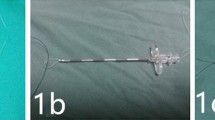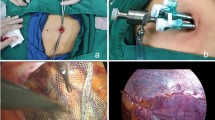Abstract
Purpose
Single-port laparoscopic herniorrhaphy is widely employed for indirect inguinal hernia repair in children. However, few surgeons utilize the single-port technique to repair such hernias with concealed deferent ducts. The aim of this study was to assess the application of the modified single-port laparoscopic technique (MSPT) in cases with concealed deferent ducts and to compare the results to those obtained with the two-port technique (TPT).
Methods
Between January 2006 and January 2012, all consecutive cases were retrospectively studied. The inclusion criteria were as follows: (1) age no more than 3 years; and (2) a concealed deferent duct identified by laparoscopy. Two-hundred and three children were treated using TPT from January 2006 to December 2008. One-hundred and ninety-three children were treated using MSPT from January 2009 to January 2012. The clinical variables and surgical outcomes were compared between the two groups.
Results
The differences in operation duration, vessel injury, conversion, postoperative hydrocele occurrence and umbilical hernia were not significant between the two groups. Ipsilateral groin swelling was more common in the MSPT group. No wound infection, recurrence, metachronous hernia or testicular atrophy occurred in either group.
Conclusions
Despite the high incidence of ipsilateral groin swelling, MSPT is a feasible alternative to TPT in children with indirect inguinal hernias with multiple peritoneal folds. Furthermore, we have developed a new method to explore the contralateral groin using a single-port technique.



Similar content being viewed by others
References
Mollen KP, Kane TD (2007) Inguinal hernia: what we have learned from laparoscopic evaluation of the contralateral side. Curr Opin Pediatr 19(3):344–348. doi:10.1097/MOP.0b013e3281574597
Esposito C, St Peter SD, Escolino M, Juang D, Settimi A, Holcomb GW 3rd (2014) Laparoscopic versus open inguinal hernia repair in pediatric patients: a systematic review. J Laparoendosc Adv Surg Tech Part A 24(11):811–818. doi:10.1089/lap.2014.0194
Alzahem A (2011) Laparoscopic versus open inguinal herniotomy in infants and children: a meta-analysis. Pediatr Surg Int 27(6):605–612. doi:10.1007/s00383-010-2840-x
Yamoto M, Morotomi Y, Yamamoto M, Suehiro S (2011) Single-incision laparoscopic percutaneous extraperitoneal closure for inguinal hernia in children: an initial report. Surg Endosc 25(5):1531–1534. doi:10.1007/s00464-010-1430-2
Montupet P, Esposito C (2011) Fifteen years experience in laparoscopic inguinal hernia repair in pediatric patients. Results and considerations on a debated procedure. Surg Endosc 25(2):450–453. doi:10.1007/s00464-010-1188-6
Draus JM Jr, Kamel S, Seims A, Rescorla FJ (2011) The role of laparoscopic evaluation to detect a contralateral defect at initial presentation for inguinal hernia repair. Am Surg 77(11):1463–1466
Endo M, Watanabe T, Nakano M, Yoshida F, Ukiyama E (2009) Laparoscopic completely extraperitoneal repair of inguinal hernia in children: a single-institute experience with 1,257 repairs compared with cut-down herniorrhaphy. Surg Endosc 23(8):1706–1712. doi:10.1007/s00464-008-0300-7
Dutta S, Albanese C (2009) Transcutaneous laparoscopic hernia repair in children: a prospective review of 275 hernia repairs with minimum 2-year follow-up. Surg Endosc 23(1):103–107. doi:10.1007/s00464-008-9980-2
Patkowski D, Czernik J, Chrzan R, Jaworski W, Apoznanski W (2006) Percutaneous internal ring suturing: a simple minimally invasive technique for inguinal hernia repair in children. J Laparoendosc Adv Surg Tech Part A 16(5):513–517. doi:10.1089/lap.2006.16.513
Ozgediz D, Roayaie K, Lee H, Nobuhara KK, Farmer DL, Bratton B, Harrison MR (2007) Subcutaneous endoscopically assisted ligation (SEAL) of the internal ring for repair of inguinal hernias in children: report of a new technique and early results. Surg Endosc 21(8):1327–1331. doi:10.1007/s00464-007-9202-3
Li B, Nie X, Xie H, Gong D (2012) Modified single-port laparoscopic herniorrhaphy for pediatric inguinal hernias: based on 1,107 cases in China. Surg Endosc 26(12):3663–3668. doi:10.1007/s00464-012-2396-z
Shalaby R, Ismail M, Samaha A, Yehya A, Ibrahem R, Gouda S, Helal A, Alsamahy O (2014) Laparoscopic inguinal hernia repair; experience with 874 children. J Pediatr Surg 49(3):460–464. doi:10.1016/j.jpedsurg.2013.10.019
Chan KL, Tam PK (2004) Technical refinements in laparoscopic repair of childhood inguinal hernias. Surg Endosc 18(6):957–960. doi:10.1007/s00464-003-8263-1
Bharathi RS, Arora M, Baskaran V (2008) How we “SEAL” internal ring in pediatric inguinal hernias. Surg Laparosc Endosc Percut Tech 18(2):192–194. doi:10.1097/SLE.0b013e31816a0645
Tam YH, Wong YS, Pang KK, Tsui SY, Mou JW, Houben CH, Chan KW, Lee KH (2013) Unexpected metachronous hernia development in children following laparoscopic unilateral hernia repair with negative evaluation for contralateral patent processus vaginalis. J Laparoendosc Adv Surg Tech Part A 23(3):287–290. doi:10.1089/lap.2012.0365
Juang D, Garey CL, Ostlie DJ, Snyder CL, Holcomb GW 3rd, St Peter SD (2012) Contralateral inguinal hernia after negative laparoscopic evaluation: a rare but real phenomenon. J Laparoendosc Adv Surg Tech Part A 22(2):200–202. doi:10.1089/lap.2011.0092
Uchida H, Kawashima H, Goto C, Sato K, Yoshida M, Takazawa S, Iwanaka T (2010) Inguinal hernia repair in children using single-incision laparoscopic-assisted percutaneous extraperitoneal closure. J Pediatr Surg 45(12):2386–2389. doi:10.1016/j.jpedsurg.2010.08.037
Rothenberg SS, Shipman K, Yoder S (2009) Experience with modified single-port laparoscopic procedures in children. J Laparoendosc Adv Surg Tech Part A 19(5):695–698. doi:10.1089/lap.2009.0148
Chang YT, Wang JY, Lee JY, Chiou CS (2009) A simple single-port laparoscopic-assisted technique for completely enclosing inguinal hernia in children. Am J Surg 198(1):e13–e16. doi:10.1016/j.amjsurg.2008.11.047
Cho A, Basson S, Tsang T (2013) Outcomes of a structured training programme for paediatric laparoscopic inguinal hernia repair. J Pediatr Surg 48(2):404–407. doi:10.1016/j.jpedsurg.2012.11.022
Saka R, Okuyama H, Sasaki T, Nose S, Yoneyama C (2014) Safety and efficacy of laparoscopic percutaneous extraperitoneal closure for inguinal hernias and hydroceles in children: a comparison with traditional open repair. J Laparoendosc Adv Surg Tech Part A 24(1):55–58. doi:10.1089/lap.2013.0109
Li S, Liu L, Li M (2014) Single-port laparoscopic percutaneous extraperitoneal closure using an innovative apparatus for pediatric inguinal hernia. J Laparoendosc Adv Surg Tech Part A 24(3):188–193. doi:10.1089/lap.2013.0288
Schier F (2006) Laparoscopic inguinal hernia repair-a prospective personal series of 542 children. J Pediatr Surg 41(6):1081–1084. doi:10.1016/j.jpedsurg.2006.02.028
Muensterer OJ (2011) Multimedia manuscript: inguinal hernia repair by single-incision pediatric endosurgery (SIPES) using the hydrodissection-lasso technique. Surg Endosc 25(10):3438–3439. doi:10.1007/s00464-011-1713-2
Acknowledgments
This work was supported by the Medical Scientific Research Foundation of Guangdong Province (China A2013577) and the Science and Technology Planning Project of Panyu District (China 2012-Z-03-37).
Author information
Authors and Affiliations
Corresponding author
Ethics declarations
Conflict of interest
YHP declares no conflict of interest; CQL declares no conflict of interest; ZH declares no conflict of interest; XYN declares no conflict of interest; and WBL declares no conflict of interest.
Ethical approval
This study's protocol was approved by the committee on human research at the Affiliated Hexian Memorial Hospital of Southern Medical University.
Informed consent
Informed consent was obtained from all individual participants included in the study.
Rights and permissions
About this article
Cite this article
Peng, Y., Li, C., Han, Z. et al. Modified single-port vs two-port laparoscopic herniorrhaphy for children with concealed deferent duct: a retrospective study from a single institution. Hernia 21, 435–441 (2017). https://doi.org/10.1007/s10029-016-1533-3
Received:
Accepted:
Published:
Issue Date:
DOI: https://doi.org/10.1007/s10029-016-1533-3




